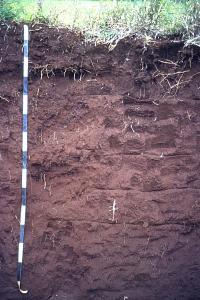Reference soil Kenya 01: Nitisol
Nitisols occur mainly in the tropics and subtropics, as well as in areas with a Mediterranean type of climate. They are associated with basic rocks (e.g. basalts) or hard limestone or dolomite deposits.
Characteristics
Soils having a nitic horizon (a horizon with pronounced nut-shaped soil structure and significant amount of active iron) within 100 cm from the soil surface, and gradual to diffuse horizon boundaries between the surface and the underlying horizons. They do not have a ferric, plinthic or vertic horizon within 100 cm from the soil surface.
Reference soil KE001: Nitisols
Authors: Kenya Soil Survey (KSS), officers Rachilo and Michieka. Topography and landform: The area has an almost flat topography, the slope gradient increasing to the North and East to gently undulating, thus inducing a N-NE aspect of land. Situated on a broad interfluve at an altitude of 1700 m the landform is characteristic for a large area East of the Rift Valley, which has been named "broad ridge topography" by Scott (1963), or as "volcanic ridge landscape". The ridge on which NAL is located is bordered to the South by the valley of the upper Nairobi river, which flows from West to East and to the North by a canalized stream following the same direction. Both streams contribute to the Athi river. Vegetation and land use: The original vegetation of bushed and wooded grassland with characteristically broad-leaved trees such as Combretum and Croton macrostachys with mostly evergreen shrubs made way a long time ago for arable cropping and exotic tree and bush species. Present cropping experiments on the station include plants like maize, sunflower, pulses, tomatoes, irish potatoes and flowers. Prior to these coffee (Arabica) was grown. These and other crop trials may have influenced the fertility status of the (top)soils. Brief description of the profile: The typical soil at the NAL is described as well-drained, very deep, dark reddish brown to dark red, friable clay. Additional notes on profile description: Ah: in the upper 5 cm weak sealing occurs; AB: also many fine and few medium pores. In a thin section taken from the Bt2 at 110-120 cm micro-cutans are obseved and occasionally clay filling occur. There is also common soil fauna activity mainly by termites and millipeds, as evident from channels and aggrotubules. Rooting is very deep, the bulk of roots is concentrated in the top 60 cm. Climatic data: mean monthly potential evaporation in mm; period 1921-1962 and 1965.
